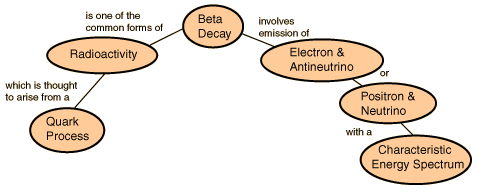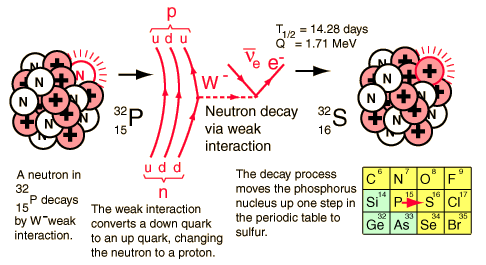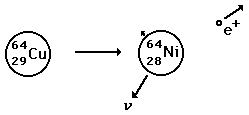
| Decay of the neutron | Fermi theory of beta decay |
| Non-conservation of parity in beta decay |
| HyperPhysics***** Nuclear | R Nave |

|
Index | |||
|
Go Back |
Beta Radioactivity

|
Index Beta decay concepts | |||||||||
|
Go Back |
Electron and AntineutrinoEarly studies of beta decay revealed a continuous energy spectrum up to a maximum, unlike the predictable energy of alpha particles. Another anomaly was the fact that the nuclear recoil was not in the the direction opposite the momentum of the electron. The emission of another particle was a probable explanation of this behavior, but searches found no evidence of either mass or charge. Pauli in 1930 proposed a particle called a neutrino which could carry away the missing energy and momentum. With no charge and no mass, it was hard to detect, and not until 1953 was experimental detection of the neutrino achieved. For symmetry reasons, the particle emitted along with the electron from nuclei is called an antineutrino. The emission of a positron is accompanied by a neutrino. |
Index Beta decay concepts | ||
|
Go Back |
Positron and NeutrinoThe emission of a positron or an electron is referred to as beta decay. The positron is accompanied by a neutrino, a massless(?) and chargeless particle. Positrons are emitted with the same kind of energy spectrum as electrons in negative beta decay because of the emission of the neutrino.  |
Index Beta decay concepts | ||
|
Go Back |
Beta Energy SpectrumIn the process of beta decay, either an electron or a positron is emitted. Because either a neutrino or an antineutrino is emitted as well, there is a spectrum of energies for the electron or positron, depending upon what fraction of the reaction energy Q is carried by the massive particle. The shape of this energy curve can be predicted from the Fermi theory of beta decay. 
|
Index Beta decay concepts Reference Halliday, Resnick, Walker Sec. 47.5 | ||
|
Go Back |